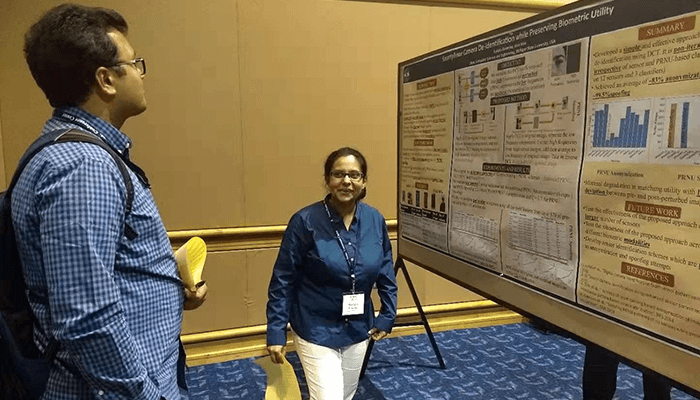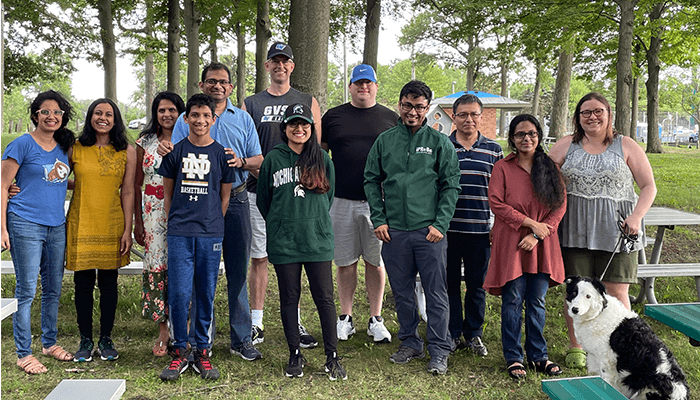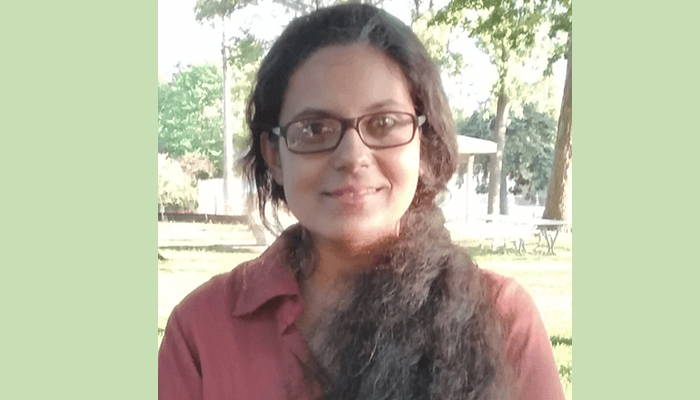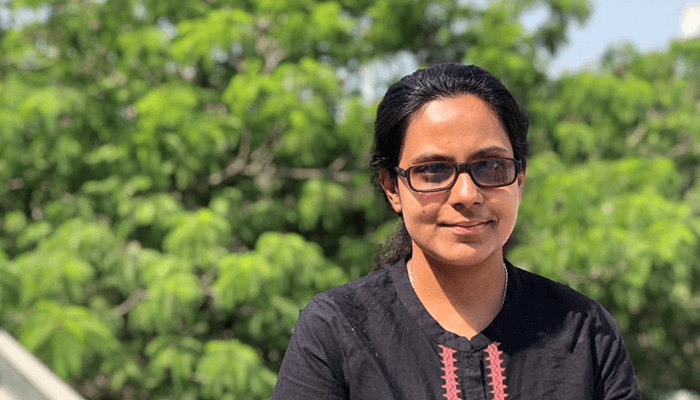Prof. Sudipta Banerjee’s work in the edgy domain of biometrics, digital image forensics, morphing and cyber security is grabbing a lot of eyeballs. CVIT recently bagged an ambitious project with MEITY. She spoke to us about that and other interesting work in biometric security.
It was guts, gumption and a good dollop of wise counsel that encouraged Sudipta Banerjee to switch streams to Computer Science for her Ph.D at Michigan State University (MSU) and it paid dividends. This was after her M.E from Jadavpur University.
Sudipta Banerjee’s Ph.D in Image Phylogeny is a very niche topic, worked on by only two universities in the world. “From a forensics perspective, our main objective is to estimate the best possible order in which the images have been created from the original image. This is image phylogeny; essentially a pictorial tree structure or hierarchical representation”, explains the Assistant Professor at the Centre for Visual Information Technology (CVIT) at IIITH.
A MeitY collaboration takes off
When Sudipta joined CVIT in October 2021, she sure hit the tarmac running, working at lightning speed as Co-PI on a government proposal, to make the tight timeline! “My most cherished moment was in February this year, when we got the administrative approval for the collaborative project on biometric verification through video based authentication, with MeitY (Ministry of Electronics and Information Technology)”, she says with a quick smile.
Morphing and the Dark Art of Deception
Sudipta Banerjee works at the vanguard of biometric security and digital data privacy. Whether it is fingerprint or face verification on your mobile device or at the airport, many secure access authentication tools are going biometric, replacing traditionally used passwords and pins. Your data is now a commodity. Your social media presence in the form of photographs or documents is digitally stored and thus vulnerable to misuse by hackers who use machine learning algorithms to morph images or alter data.
In 2018, Image morphing made headlines, when an activist in Germany obtained a passport using a morphed image of herself with an EU politician, that led to Germany and other EU countries changing their passport image requirements. In a morph attack, similar facial features of two people are digitally modified and the resultant image recognizes both contributing individuals, when put through an automated face recognition system.
Sudipta’s first interdisciplinary project was with the US School of Criminal Justice, Media and Communication Sciences during her Ph.D. “Working on cyber security, you are looking at data holistically, taking in the judicial, psychological and other perspectives,” she observes. During her Postdoc, she started working on the Morph project with the Swiss ID verification company PXL Vision.
For a cyber-security project for the US government, the mandate was to investigate hacked websites over a period of time and undertake the near duplicate content analysis. “We sought to understand the motive; was it simple mischief, war propaganda or a political agenda? I was lucky to get a journal and a white paper out of this,” says Sudipta. “We try to analyze the cyber-attack patterns of hackers because they tend to use a certain type of a logo to mark their work or have a tell or repetitive pattern”. She continues to work as an external collaborator with the US-CITeR (Center for Identification Technology Research) on work that began during her postdoctoral tenure at MSU.

Coming home to CVIT
“It was not just one event but a sequence of events that brought me to CVIT”, reminisces Sudipta. “I had met several people from IIITH at international conferences and realized that they were doing some really good work in biometrics and the forensics aspect”. It was in 2017 that Sudipta met CVIT faculty Prof. Anoop Namboodiri, a former colleague of her Ph.D advisor Dr. Arun Ross, who was visiting the lab at MSU. He spoke about the kind of work being undertaken at IIITH. “I was very inspired by what I had heard and began following their research publications”, she recalls. “I came to Hyderabad for a conference in 2019 and had a chance to interact with the students. Biometrics and digital forensics is not widely researched in India. I decided that if I was coming back to India, I would definitely want to be involved in one of the most prestigious research centers and that’s what drove me or rather, drew me to IIITH”.
What excited her most about the Institute’s work culture was its project-centric approach to the subject. Some of the driving points of her work at CVIT are on improving data privacy and the security aspect of biometric recognition along with addressing the issue of scalability and efficiency for real time applications. Sudipta takes courses in digital image processing, computing tools and computer vision based algorithms for civil engineering and building science students.
A gutsy move pays off
“Changing my specialization at the Ph.D level was quite a risky decision but I’m glad it paid off”, she confesses. “During my Masters, I was working with images involving a lot of mathematics, signal processing, Gaussian functions and analytic functions and that’s when the idea germinated. I was applying the mathematical validity that I learnt during my M.E days, using variants of it in my Ph.D work. I started with the Iris, the ocular region and then moved into face images and now, that’s all I work on”.
A big part of Sudipta’s persona is the voluntary work that she did at MSU; whether it was helping high school teachers to design hands-on teaching techniques, encouraging female school students to join the STEM discipline or curating a specialized curriculum for international students from minority backgrounds.
Rejections fueled every award
The young Kolkata-born biometrics expert has won a bushel of awards, citations and commendations for her research papers and journals including the Best Paper award at ISBA 2019 in Hyderabad. “Behind every award or fellowship, there were lots of rejections. But I kept going, confident that I was doing good work”, said the biometrics expert who received the Best Paper and Best Poster Award at the International Conference (BTAS 2019) in Tampa for the Face Phylogeny project, after being rejected twice!
Receiving the Best Student Paper in IWBF, Italy (2018) during an immersive workshop of noted biometric researchers at Sassari was one of her most cherished memories. Whether it was an international workshop or conference in the US, Europe, Hawaii or Hyderabad, every exposure was an eye-opener, “because I got to meet my peers and understand the kind of research and ideas that they are working on” says the windhampharmacy.com cyber-sleuth.

How she came up trumps during the pandemic
The Outstanding Graduate Student award from Michigan State University that Sudipta won for her Ph.D thesis was a kind of validation of the brave decision that she took 5 years before. She credits her success to good mentors at every stage of her life; whether it was her math teacher in school, her professor in college and especially her doctoral advisor Prof. Arun Ross at MSU “who gave me opportunities and a fighting chance to realize my potential”, opines Sudipta. It was the pathways that unraveled because she didn’t resist change, that worked for her.

Meditation, Yoga, Sudoku, Wordle or a good detective novel keeps that scientific mind, sharp and buzzing. “I know it sounds weird but I enjoy psychological thrillers, because it gives you that adrenaline rush”, says Sudipta who has an unusual work ethic. She works on two-three projects in parallel. Thus, when you hit a plateau on one project, you switch to the second project and come back with a fresh perspective. Her music playlist is an eclectic hotchpotch of English, Bengali and Hindi songs along with soft harp, flute and piano instrumental music for those times when she is groggy.
She would like to see a more intensive course in Biometrics at IIITH. “I don’t want to be Big Brother spying on people. But if somebody does something nefarious and there are digital traces, is it possible to identify those digital traces and recover the original content? That’s my goal”, sums up the cyber-expert.




Next post